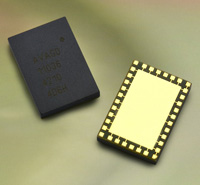- News
28 March 2011
Avago debuts fail-safe bypass LNA modules for cellular infrastructure
Avago Technologies has launched a series of fail-safe bypass low-noise amplifiers (LNAs) for tower-mounted amplifiers (TMA) and base transceiver stations (BTS) applications. The new ALM-11x36 modules can replace large discrete and surface-mount component counts in conventional designs, shortening design cycle time and providing savings in board space.
 Operating from a single 5V power supply, the modules have low noise and high linearity through use of the firm’s proprietary 0.25 micron GaAs enhancement-mode pHEMT process. Their bypass isolation eliminates the possibility of oscillation issues, and the modules also feature low bypass insertion loss and high input and output return loss. In addition, the ALM-11x36 LNAs have a fail-safe bypass function, which is especially critical for TMA applications to enable the LNA bi-directional bypass path during the absence of DC power supply.
Operating from a single 5V power supply, the modules have low noise and high linearity through use of the firm’s proprietary 0.25 micron GaAs enhancement-mode pHEMT process. Their bypass isolation eliminates the possibility of oscillation issues, and the modules also feature low bypass insertion loss and high input and output return loss. In addition, the ALM-11x36 LNAs have a fail-safe bypass function, which is especially critical for TMA applications to enable the LNA bi-directional bypass path during the absence of DC power supply.
All matching components are fully integrated within the modules, and the 50 ohm RF input and output pins are already internally AC-coupled. This makes the modules easy to use, says Avago, as the only external parts required are DC supply bypass capacitors.
The LNA modules perform across a wide range of bands, with the ALM-11036 covering 776–870MHz, the ALM-11136 covering 870–915MHz, the ALM-11236 covering 1710–1850MHz, and the ALM-11336 covering 1850–1980MHz. All share the same compact 7.0mm by 10.0mm by 1.5mm package and pin-out configuration, and hence suit common platform designs.
The wireless infrastructure industry must provide optimum coverage with the best signal quality in a crowded spectrum, comments Avago. Receiver sensitivity is the most critical requirement in a BTS receiver’s design, and LNA selection greatly affects the receiver’s performance. For front-end design architectures with a bypass path, low noise figure (NF) and bypass insertion loss (IL) are the key design goals. NF and bypass IL are, respectively, 0.78dB and 0.82dB for the ALM-11036, 0.76dB and 0.85dB for the ALM-11136, 0.67dB and 0.75dB for the ALM-11236, and 0.72dB and 0.78dB for the ALM-11336.
Another key design factor is linearity — specified by input third-order intercept (IIP3) — which affects the receiver’s ability to distinguish between wanted and spurious signals that are closely spaced. IIP3 is 21.3dBm for the ALM-11036, 22.0dBm for the ALM-11136, 17.3dBm for the ALM-11236, and 17.9dBm for the ALM-11336.
Join Semiconductor Today's LinkedIn networking and discussion group
